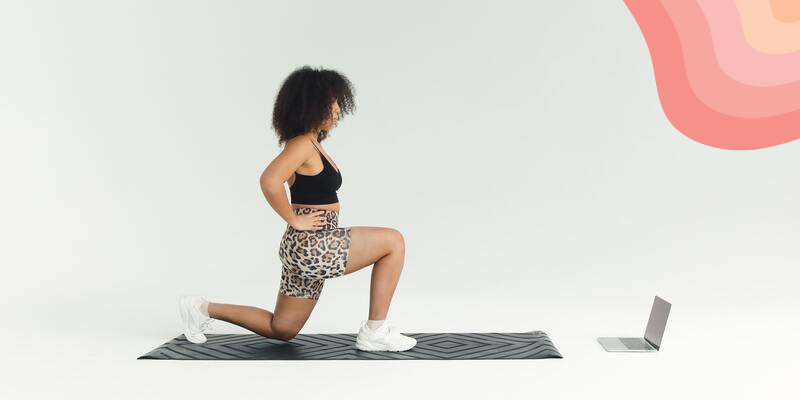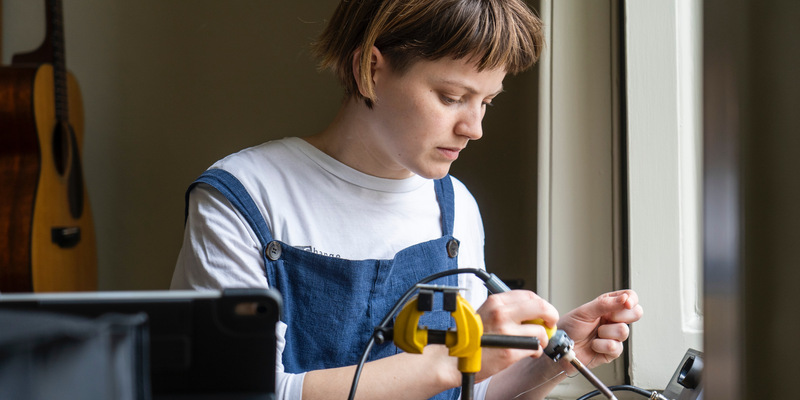Oxford University explores flow state secrets and focus with FLOWN

By Micah Yongo
•
Jul 05, 2023
'True behaviour change is identity change. You might start a habit because of motivation, but the only reason you'll stick with one is that it becomes a part of your identity.’
Just one of the thoughts shared during a recent talk I gave for students and faculty at the University of Oxford this past week, unpacking how postgrads and professionals can better harness one of the most crucial tools at their disposal — motivation.
Often we think of motivation as some abstract feeling, an inward drive to do things — build a business, write a book, top your last Candy Crush score, whatever. Seldom do we think of it as having a neurochemical base, or an evolutionary root.
And rarely, if ever, would we imagine we can use this knowledge to help trigger and leverage it toward our own aims: to discover ways to stay motivated with long term goals in a way that actually works with the way we’re naturally wired, rather than against it.
Which is why I was keen, during my talk, to share insights and techniques I’ve found to be especially impactful in my own work, as well as with those I coach.
Here are three of them…
1. Map your focus and flow states

Once upon a time people thought of flow as this sort of woo-woo magical idea. I mean, you can see people talking about this stuff all the way through history.
You’ve got the 9 muses of Greek mythology — gods of the arts and creativity etc.
Whenever the ancient Greeks found themselves inspired to unusual feats of rhetoric or innovation or performance, they’d attribute those moments of heightened insight and ability to entities beyond themselves.
Which makes sense, doesn’t it. Because that’s how it often feels when you’re really on… you’re completely immersed in what you’re doing. It becomes effortless to the point that it no longer feels like you doing it. You surprise yourself.
But it’s only a surprise because those moments are moments… occasional fleeting experiences. But what if you could work from that kind of state consistently? What if you could control it, make flow your norm?
Discover how to unlock flow states through deep work

Well this is where the rubber hits the road, because flow is not actually woo-woo, magical or mythical at all… flow has a psychology, and a biology.
Which means that when it comes to flow, it isn’t just about what you’re doing and how you’re doing it, it’s also about when.
Biorhythms.
Your body has a clock. That clock is mediated by the release and absorption of hormones within your bodily systems by a group of around 20,000 neurons in your brain. These neurons form a structure called the suprachiasmatic nucleus (yeah, we’ll call it the SCN from hereon, most people do).
The thing about it is the SCN receives its input mostly from the eyes. It’s triggered by light.
Which means, the level and type of light you expose yourself to, and when, can directly impact your body’s physical state and energy levels.
This stuff can shape your digestion, metabolism, your general health, and your brain’s ability to focus.
So, here’s what you need to do…
First, you’ve got to build routines that protect your body’s normal rhythms:
Take in some sunlight early in your day to reinforce your body’s biological cues.
Don’t take long naps and don’t nap too close to bedtime.
Aim to sleep and wake up at the same time every day.
Exercise during the day — this’ll make it easier to sleep at night and keep to your usual waking hours.
Avoid caffeine after 12 p.m. I know, you hate me now, and we were getting on so well. But you need to protect your sleep at all costs. This is a biggie.
Avoid artificial light from electronic devices before bed. You already know this. Blue light. This stuff will jack up your body’s waking rhythms in a heartbeat
But these are just the basics. Once you’ve made these things a habit, to take your experience of flow states to the next level you need to start charting the time of day you feel at your most energized.
Here’s a simple method I use with those I coach.
- Build a chart (or download ours - see below), then use it to rate your mood and energy levels on a scale of 1-5 every three waking hours. So… 9AM, 12PM, 3PM, 6PM, 9PM
- Do this for a week. Then review your ratings to find the window you feel at your best.
- Once you know your window, protect it. No meetings, socializing, calls etc.
- This window is your flow state haven. Block it out, choose a meaty task, and allocate it to this specific interval of your day for you to work on.
Congrats. You now know what not to do, and you know when to work to be at your best, but what are the brain triggers that are gonna allow you to flip into deep work/flow mode when you sit down at your desk?
Build flow state rituals
“We just need to be clear about our intention (what are we inviting into this moment?), bring it our attention, and make space for repetition.”
Now, OK, I get it… you hear the word ritual and you immediately start thinking of strange secret society initiations. But look, just because some folks use rituals that way, doesn’t mean we all have to.
Kinda like breadknives...
Sure, you can use one as a screwdriver (what, only me?), but that doesn’t mean it’s what they’re necessarily best for.
A quick dip into the behavioural science on this stuff and you quickly realise that rituals can be pretty nifty things. They're not habits—repeated activities that exist for their own sake. A ritual is a specific and repeatable action that prepares you for an activity. They get the brain ready for the thing you want it to do.
All time great tennis player Rafa Nadal picking at his shorts, in the exact same way every time, right before he’s gonna serve a tennis ball.
Rugby legend Jonny Wilkinson squatting down slightly and cupping his hands, right before he’s gonna kick a penalty.
As far back as humans go we’ve been using rituals, consciously and unconsciously, to commemorate or prepare for our events and the things we need to do… but why?
Well, here’s what we know...

Rituals are proven to help build associations and patterns in the brain.
You read the story to the child at bedtime, perhaps even the same story, and they fall asleep by the time you get to the sixth page. Every time.
The experience of that action has become so routinized and linked to the activity that follows that the brain’s pathways have become shaped around it.
This is exactly how rituals work. They connect you to the headspace you need for the activity you’ve trained your brain to associate it with. They create a neural trigger.
Do ritual—now, kick the goal. Do ritual—now, serve the ball. Do ritual—now, fall asleep.
Do ritual—now, enter flow…
So, here’s what you need to do.
Choose a specific, repeatable, and preferably pleasurable activity to do before you do deep work. It can be as simple as brewing a cup of coffee, doing a specific set of exercises, or even journaling for a set amount of time.
You choose. It just needs to be easily repeatable, and it’s best if it’s something tactile.
Personally, I use breathwork, which in my opinion is the best ritual for deep work (more on that here).
Now, every time you’re going to do deep work, you need to do the ritual you’ve created right before it. And I mean every time.
Doing this will create a series of neural cues that will eventually lead to your brain becoming habituated to deep work and primed for it in response to the ritual you’ve chosen.
To add extra reinforcement you can even introduce particular elements to the ambience in which you perform the ritual and do deep work. Certain types of music, lighting, or even smells.
Discover how to use music to unlock your flow

Having these supplementary cues will make the ritual that much more immersive for your brain. Eventually, you’ll be able to consistently get into the state you need for flow, almost on demand.
OK, so you’ve now got a pretty strong set of tools for how to find your flow more readily. But there’s still a crucial final piece to this puzzle.
Because when it comes to flow, not all tasks are created equal.
I mean, sure, it’s possible for flow states to be experienced in almost any activity—but some are better suited than others.
So, how can you become more strategic in what you choose to work on, and when, so that you can build your flow and get more done, more easily?
Game your momentum
“Momentum begets momentum.”
So, inconvenient truth… your brain doesn’t do long-term goals. Or at least it doesn’t really want to.
That stuff is to do with your prefrontal cortex — delayed gratification, future orientation, executive function — i.e. all the high cognitive load type stuff that makes us human, but that isn’t necessarily the neurophysiological path of least resistance when it comes to hunkering down to challenging tasks.
This is to do with what thinkers like Robert Sapolsky might term your ‘mammalian brain’ — the sophisticated set of urges and impulses lurking deep down in your amygdala and limbic system that are primarily oriented around immediate goals with immediate rewards.
It’s a part of your wiring that is, from an evolutionary standpoint, a fair bit older than our more enlightened, decision-making parts, and thereby far more efficient.
Which is why we find being patient difficult. And also why you’re more likely to sneak a taste of that last cookie in the cookie jar rather than resist the urge to do so.
We like rewards that are instant, here and now. And achieving them delivers a handy dopamine hit — the brain hormone most responsible for granting a feeling of accomplishment, and driving us to repeat the behaviors its release was triggered by.
Which isn’t great when you’re trying to make meaningful progress toward big long-term goals.
So, what’s the fix?
When you plan small wins into your day, you give your brain an opportunity to deliver that tasty dopaminergic response its looking for; which, in turn, actually fuels your motivation.
So, try this…
- Choose a time to focus on your big task.
- Before you get into the meaty work, work on something light touch instead; a small and easy task you know you can complete within 10 mins — answering an email, planning your day/week, whatever.
- The feeling of accomplishment from completing this small win will juice up your dopamine response — which, along with being the reward hormone, also regulates the brain’s ability to harness your attention. It helps you focus.
And voilà, you’ve reduced the friction of doing your big thing and fuelled yourself to focus with greater ease.
You’re welcome 😉.
Flow your way to long-term success
What really struck me when sharing these and many other insights with the bright minds at Oxford University is just how needed these tools and tricks are.
We're usually pretty good at identifying what we want to achieve — we can list our tasks and set our goals. But when it comes to knowing how to get there, well, that's often where we trip up.
We're so focused on the 'what,' but the 'how' (and let's not even start on the 'why') can leave us scratching our heads.
One of the most valuable things you can do to overcome this is to get a real understanding of what makes you tick, and your work-style. Once you get a proper handle on the way you’re wired you can soon use this knowledge to your advantage to keep our momentum going strong, without feeling like you’re constantly swimming upstream.
If you’d like extra support with this, take a look at FLOWN Plus to discover how you can access bespoke expert support designed to unlock your focus and productivity, and spur you on toward your big goals.
And if, like Oxford University, you'd like to help your team or business thrive in their work, you too can access productivity training and focus coaching with FLOWN.

















